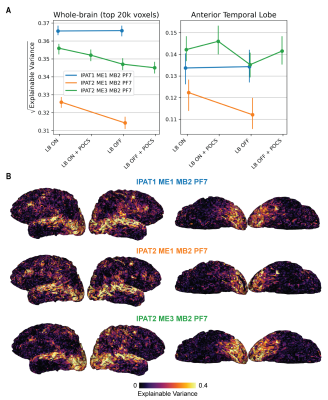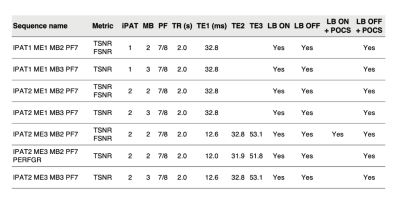Matteo Visconti di Oleggio Castello1, Valentina Borghesani2, Katherine P. Rankin3, Jack L. Gallant1, and An T. Vu3,4
1University of California, Berkeley, Berkeley, CA, United States, 2Université de Montréal, Montréal, QC, Canada, 3University of California, San Francisco, San Francisco, CA, United States, 4San Francisco Veteran Affairs Health Care System, San Francisco, CA, United States
1University of California, Berkeley, Berkeley, CA, United States, 2Université de Montréal, Montréal, QC, Canada, 3University of California, San Francisco, San Francisco, CA, United States, 4San Francisco Veteran Affairs Health Care System, San Francisco, CA, United States
We developed a multi-echo sequence optimized for whole-brain functional mapping with increased SNR in the anterior temporal lobe. Moderate iPAT and MB acceleration with LeakBlock reconstruction provided increased SNR in ATL and the whole cortex.

Figure 4. Sequence comparison with FSNR: explainable variance (EV). A) Median EV in a cortical (left) and ATL mask (right). The iPAT1 single-echo sequence (blue) shows higher EV in the whole brain than the other sequences, but the multi-echo sequence (green) shows higher EV in ATL. POCS reconstruction also improves EV in the ATL. B) EV on the cortical surface with LB ON. The multi-echo sequence (green) shows higher EV than the other sequences in temporal cortex.

Figure 1. Sequences tested. Each row indicates the metric used to assess the sequence (temporal SNR, functional SNR), in-plane acceleration factor (iPAT), multiband acceleration factor (MB), partial fourier factor (PF), TR, and echo times (TE1-3). Sequences were collected with LeakBlock on (LB ON), and were retro-reconstructed with either LeakBlock off (LB OFF), LeakBlock on and POCS (LB ON + POCS), or POCS only (LB OFF + POCS). PERFGR: gradients in performance mode.
